SHUOYING HD1Z Digital Video Camera User Manual
SHUOYING INDUSTRIAL (SHENZHEN) CO., LTD. Digital Video Camera Users Manual
SHUOYING >
Users Manual
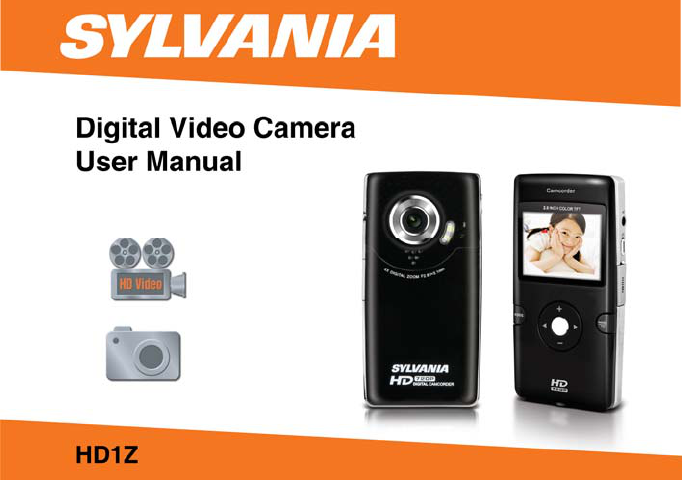
0

1
Contents
Contents………………………………………………………………………………………………………...1
Introduction……………………………………………………………………………………………………..2
Notice for use…………………………………………………………………………………………………2
System requirements…………………………………………………………………………………………4
Getting to know your camera…………………………………………………………………………………6
1. Appearance and Buttons……………………………………………………………………………..6
2. Basic operation…………………………………………………………………………………………8
3. Connect to PC……………………………………………………………………………………….12
4. Download files from camera to PC……………………………………………………………….13
Application of attached Software……………………………………………………………………………14
1. Introduction interface for software installation……………………………………………………14
2. MediaImpression Installation and Use……………….………………………………………15
3. UEZ Link Introduction and Use…………………………………………………………………… 20
Product specifications……………………………………………………………………………………27
Included materials……………………………………………………………………………………28
Remarks………………………………………………………………………………………………………29

2
Introduction
Congratulations on your purchase of this digital video camera. Before using the camera,
please read this user manual carefully. The HD1Z’s main purpose is to shoot videos. It is also
equipped with a secondary still shot feature. Please note that this is not meant to replace a
regular still shot or digital camera. It is only a side feature.
The illustrations in this user manual are to visually detail the operation of the digital video
camera.
Notice for use
General:
1. Never open the housing of the digital video camera as some parts may cause an electrical
shock.
2. Moisture, extreme pressure and overheating may damage this digital video camera.
Memory and storage:
1. SD/MMC/SDHC cards are compatible with this digital video camera, with a maximum
capacity of 16GB.
2. When buying a SD/MMC/SDHC card, take the digital video camera with you to ensure
compatibility.
3. When a SD/MMC/SDHC card is inserted, the internal memory of the digital video camera
will not function.
3
5. When storing documents using the internal memory or the memory card, make sure that the
size of the files do not exceed the capacity of the memory.
Maintenance and care:
1. To clean the lens, the first step is to blow away dust from the surface. After doing so, use a
cloth or tissue to wipe the lens. If necessary, use lens cleanser.
2. Avoid touching the lens with your fingers.
3. When left idle for long periods, remove the battery from your digital video camera and store
it in a dry and dark place.
Miscellaneous:
1. When switching video output between LCD display and video devices, be sure to exit from
the ‘play’ or ‘record’ state.
2. This digital video camera is suitable for environments between 0 °- 40 ° C or 32 °-104 ° F.
Never keep the digital video camera in extremely high temperatures, such as a car parked in
the sun. Never keep the digital video camera in damp or moist places. In order to prevent
the digital video camera from condensation, when moving from a cold to a warm place, be sure
to keep it in a sealed plastic bag. Open the bag and take it out when the camera reaches the
indoor temperature.
3. TV programs, movies, music, images and other resources may be protected by copyright;
therefore, without prior permission, do not distribute copyrighted materials.

4
System requirements
When utilizing the Arcsoft software that is included with the HD1Z, be sure the computer you
are using meets the below system requirements:
Operation System Microsoft Windows 98, 2000,XP, Vista, Windows 7
CPU Above Intel PIII667 or CPU of equal performance
Memory Above 128 MB
Sound card and display card DirectX8 or above.
CD-ROM 4× speed or above
Hard Disk 1 GB space above useable
Other One standard USB 1.1 or USB 2.0 port

5
Memories on TV 4 Software
The below chart is the minimum system requirements for the Memories on TV 4 software
which is also included in the giftbox:
Operation System Microsoft Windows XP, Vista, Windows 7
CPU Intel Pentium II 300mHz or faster
Memory 64 MB RAM (128 MB Preferred)
Sound card and display card DirectX8.1 or above.
CDR/RW 4× speed or above to burn discs
Hard Disk 36 MB available hard disk space
MOV Support Quicktime 6 and above
• CD/DVD writer to burn discs •
• DVD player must be able to play CD-R(W), DVD+R(W) or DVD-R(W) media
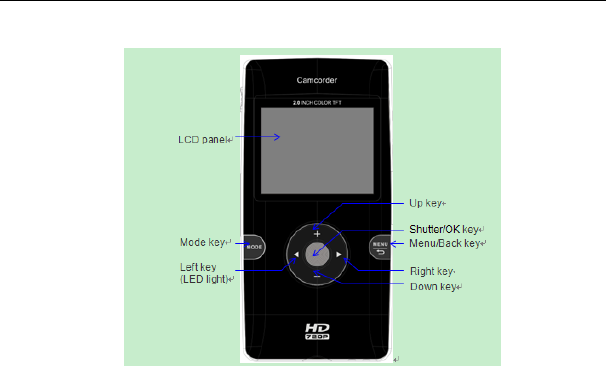
6
Getting to know your camera
1. Appearance and Buttons
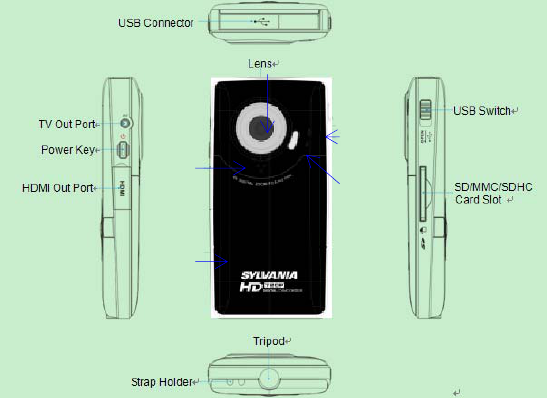
7
S
peake
r
Batter
y
Cove
r
LED li
g
ht
Bus
y
indicato
r

8
2. Basic operation
2.1 Installing the battery
Press / slide down the battery cover and insert the included lithium battery. Align with correct
polarity (+,-) of battery terminals. Close the battery cover.
2.2 Charging the battery
1. Power off the camera.
2. Connect the camera to the computer USB port or to a power adapter with the USB cable
to charge the battery.
3. During charging, the busy red light will be on. The busy light is located on the top of the
digital video camera to the left of the lens as shown on page 7. The light will turn off when the battery
is fully charged.
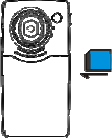
9
4. Charge the camera for about 3 hours to get maximum battery power. Battery lasts as long as 2
hours under normal usage.
2.3 Using a SD/MMC/SDHC card
Turn your camcorder OFF before inserting / removing an SD Card.
Insert a memory card into the SD/MMC/SDHC card slot. Push it down until the card stays
latched. Do not force – check card’s position according to the position
mark on the camera.
To remove card, push card inward and it will pop out automatically.
- Note that the SD Card has a tiny LOCK switch on the side. Set the
switch to the un-LOCK position to store recorded videos and still
pictures.
2.4 Powering on/off
In the power-off state, press and hold the power key to turn the camera on.
In the power-on state, press the power key to turn the camera off.
The camera will turn off automatically if it is on and left idle for 1 minute.
10
In power-on state, when the battery level is very low, the camera can turn off after several
seconds. You must recharge the battery when this happens.
2.5 Video record
Your camera will automatically go to record mode after it is powered on. To record a video,
press the shutter key to start video recording. While recording, press the shutter key again
to stop recording.
In video record mode,to change the resolution from 720p HD to VGA 640/480 and vice
versa, press the right to get your desired setting. Press the left key to turn the Led light on or
off. You can use the zoom feature by pressing the up or down key to zoom in or out on the
image before you record or while you are recording.
Please note the digital zoom feature degrades the picture the more you zoom in.
2.6 Playback videos or photos
Press the mode key to change modes, from video mode to playback mode. Once in
playback mode, press the ◄ key or ► key to select the desired file. When viewing a video
clip, press the OK key to begin playing. Press the ◄ key to rewind and the ► key to fast
forward. Press the up key to return back to normal speed. Press the OK key to pause and
resume playing. Press the down key to stop playing the video.
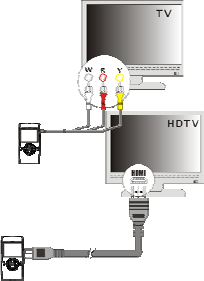
11
Press the down key again to see thumbnails of all of your videos.
When viewing a Still photo, press the up or down key to zoom in or out of the image. While
zooming, pressing the OK key can enter pan mode. At this time you can press the direction
key to move the photo to view in LCD.
2.7 Still photos
Press the Mode key to switch from playback mode to still photo mode (5MP). Press the left
key to turn the Led light on or off. In still photo mode, press the shutter key to take a picture.
Press the up or down key to zoom in or out of the image.
2.8 Video output
After the camera is powered on, insert the terminal of the TV
cable into the TV output port of the camera. The yellow port of
the other terminal should be connected to the VIDEO IN port of
the TV. The red (or white) port of the other terminal should be
connected to the AUDIO IN port of the TV as shown in this
illustration.
2.9 HDMI output
If you want to output the video and sound from the video camera to an HD TV,

12
insert a HDMI cable (not included) to the HDMI port of the camcorder and connect the other
terminal of the HDMI cable to the HD TV.
Note: During the period of HDMI output, the video camera can only enter playback mode
(you will not be able to record while the HDMI cable is connected).
2.10 Delete files
In playback mode, press the Menu key to start menu-setup, and then choose the delete item
to delete files.
3. Connect to PC
3.1 Turn the camcorder on. Slide the USB switch up to extend the USB connector.
3.2 Insert the camera’s USB connector into computer’s USB port, or use the supplied
USB extension cable to make the connection.
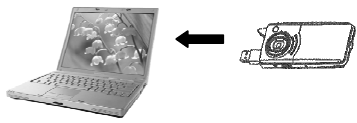
13
4. Download files from the camera to PC
4.1 After connecting to a computer, go to "My Computer” and open the "Removable Disk"
icon. The videos or photos will be saved in the \DCIM\ 100DSCIM folder in the
removable disk. Choose the desired file in the 100DSCIM folder and copy (drag with
mouse) it into a folder of your choice on your computer.
4.2 You can use ArcSoft MeidaImpression to edit videos or photos.
4.3 ArcSoft MeidaImpression can be installed from the CD included.
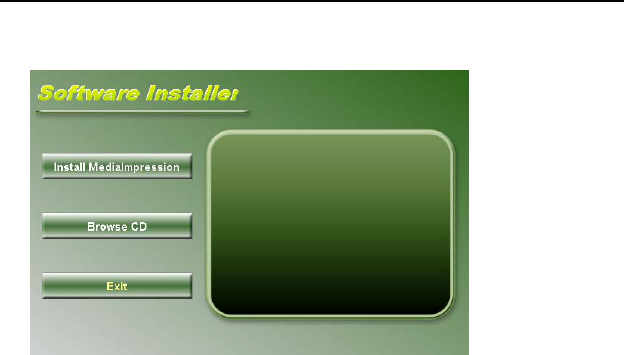
14
Application of attached Software
1. Introduction interface for software installation
Put the CD into the CD-ROM of a computer, and then the following menu will appear:
z If the above screen does not show up, click the autorun.exe program under the directory of the CD.
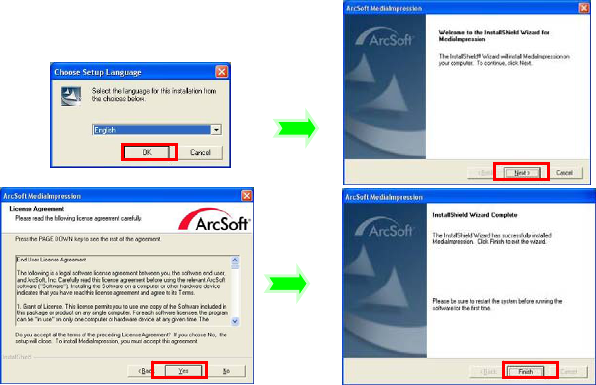
15
2. MediaImpression Installation and Use
Install MediaImpression:
Click “Install MediaImpression” button and complete the installation as per the tips.
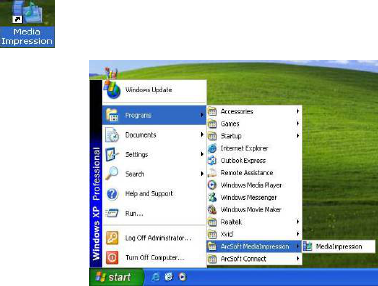
16
After installation, please restart the computer.
Run MediaImpression:
Double click the icon on the desktop or follow “Start → Programs” to open:
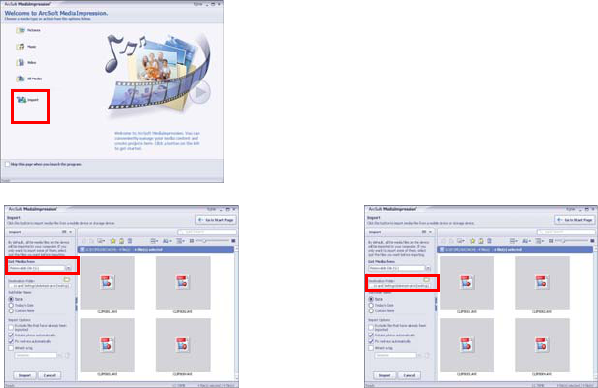
17
After starting MediaImpression, click “Import” to import the media.
Choose the video camera storage and choose the output location.
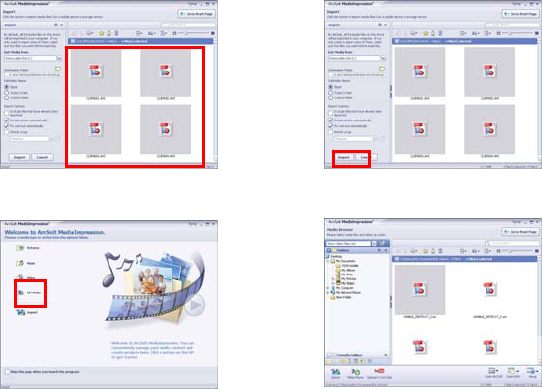
18
Choose a file and click import. The selected file will be stored in the output location.
Click “Go to start page” to return to the main screen. Then click “Video” or “All media” to use
the “You Tube” function.
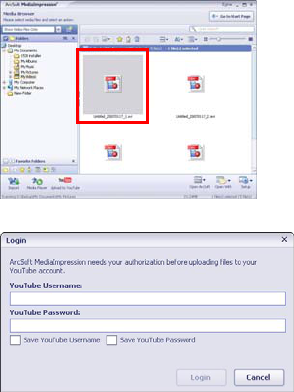
19
Choose a file and click the “upload to You Tube.
Enter your username and password to login to You Tube to execute the upload.

20
3. UEZ Link Introduction and Use
UEZ Link can help you easily upload your videos or photos to or . There
are two ways to use the software:
Ⅰ When connecting to a PC, UEZ link will pop-up automatically.Please make sure that your
PC will not block any pop-up software. Otherwise it will not work.
Ⅱ Double click the icon from the CD to run. You can also copy files to your PC,
and then double click the icon to run.
The interface below will appear:
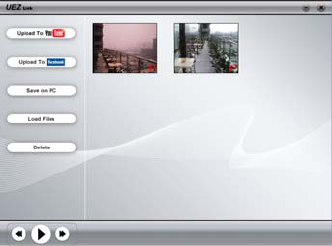
21
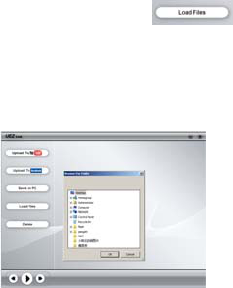
22
3.1 Load Files
UEZ link will automatically load all the files in the DCIM folder . You can load the desired
files by clicking the button , and then choosing the files. Once the “Browse for
folder” window opens, choose “Computer” then the driver where the files are located. (This
should be a “removable disk”, such as D, E, F…) Then choose the files.
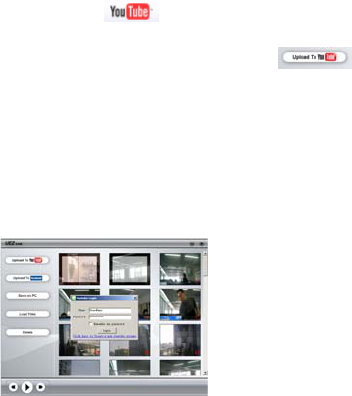
23
3.2 Upload to
Choose the file, and then click the button to upload your files. Hold the Control
key and click another file to choose multiple files to upload. Please make sure that you have
registered and activated an account for YouTube to upload videos. Otherwise, you will not be
able to upload.
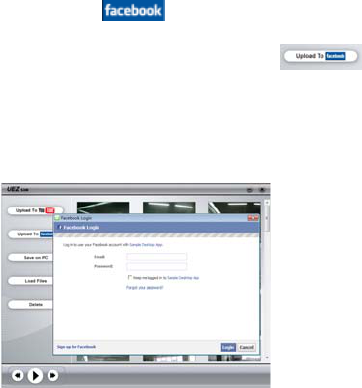
24
3. 3 Upload to
Choose the file, and then click the button to upload your files. Hold the Control
key and click another file to choose multiple files to upload. Please make sure that you have
registered and activated the account for facebook to upload files. Otherwise it will not work.
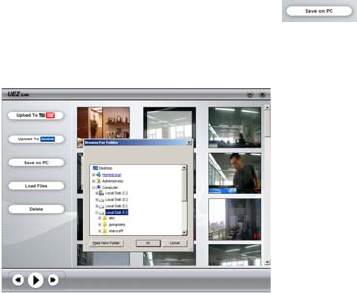
25
3.4 Save on PC
Choose the file, and then click the button to save on PC. Hold the Control key
and click another file to choose multiple files to save.
.
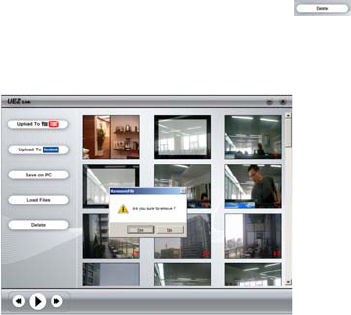
26
3.5 Delete
Choose the file, and then click the button to delete the files. Hold the Control key
and click another file to choose multiple files to delete.
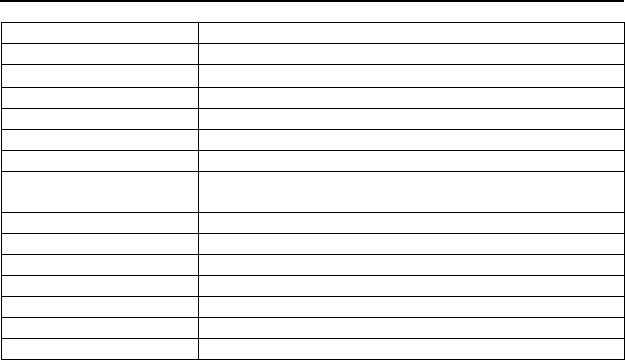
27
Product specifications
Image sensor 5.0 Mega Pixels
Function mode Record video, Record still photo, playback, mobile disk
Lens F2.8,f=3.85mm
Focus range 120cm~infinite
Digital focusing 4×
Shutter Electronic
LCD display 2.0 inch TFT Display
Resolution Video: HD(1280x720), VGA(640x480)
Still photo: 5.0MP (2592X1944)
White balance Automatic/Manual
Exposure Automatic
File format (Video)AVI, (Photo)JPEG
Video out TV out, HDMI out
Storage media SD/MMC/SDHC card(max. 16GB)
USB port USB 2.0 port
Dimension (LxWxH) 111mm × 57mm × 19.5mm
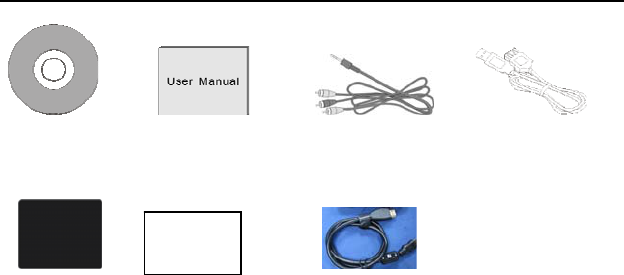
28
Included materials
Installation CD User manual TV cable USB extension cable
Battery Quick Start Guide HDMI cable
Note: The shielding USB extended cable, the TV out cable with ferrite core and the HDMI
cable with ferrite core are designed for exclusive use with this product. Don't use others for
this product
Quick Guide
29
Warning: Changes or modifications to this unit not expressly approved by the
party responsible for compliance could void the user’s authority to operate the
equipment.
NOTE: This equipment has been tested and found to comply with the limits for a
Class B digital device, pursuant to Part 15 of the FCC Rules. These limits are
designed to provide reasonable protection against harmful interference in a residential
installation. This equipment generates, uses and can radiate radio frequency energy
and, if not installed and used in accordance with the instructions, may cause harmful
interference to radio communications.
However, there is no guarantee that interference will not occur in a particular installation.
30
If this equipment does cause harmful interference to radio or television reception, which
can be determined by turning the equipment off and on, the user is encouraged to try to
correct the interference by one or more of the following measures:
Reorient or relocate the receiving antenna.
Increase the separation between the equipment and receiver.
Connect the equipment into an outlet on a circuit different from that to which the
receiver is connected.
Consult the dealer or an experienced radio/TV technician for help.